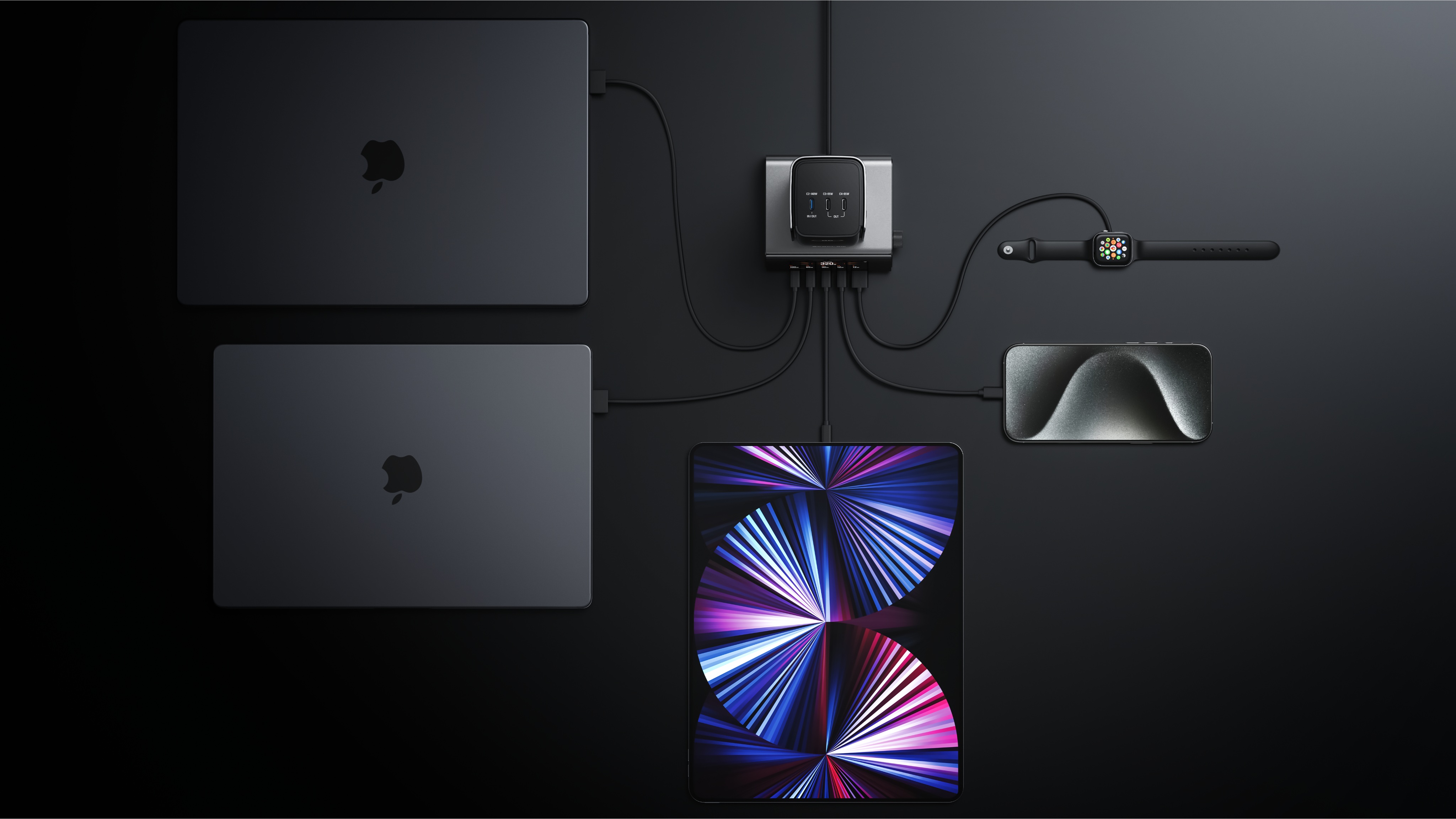Can I Use MagSafe Chargers on Androids?
Yes, you can use MagSafe chargers with Android phones that support Qi wireless charging. However, you won't get the magnetic alignment feature, as it's Apple-specific. Your Android will charge, just without the snap-on convenience iPhone users enjoy.
What Is Qi Wireless Charging and How Does MagSafe Relate to It?
Understanding the basics helps you know what to expect when mixing Apple charging tech with Android devices.
Qi Wireless Charging Standard Explained
Qi (pronounced "chee") is the universal standard for wireless charging, developed by the Wireless Power Consortium. Think of it like USB-C but for wireless power transfer. Nearly every modern phone that charges wirelessly uses this standard.
Technology works through electromagnetic induction. Your charger creates an electromagnetic field, and your phone has a coil that converts that field into electrical current. It's the same principle that powers electric toothbrush chargers you've been using for years.
MagSafe as an Enhanced Qi Wireless Charger
Apple's MagSafe is essentially a Qi wireless charger with magnets built in. The charging part uses standard Qi technology, but Apple added a ring of magnets around the charging coil. These magnets align your phone perfectly over the charging coil and hold it securely in place.
The magnetic ring doesn't actually transmit power - that's still the Qi coil doing the work. The magnets ensure your phone sits in the optimal charging position.
In practical use, that means a good MagSafe-style stand or pad can keep your phone centered for efficient charging without you having to fuss over placement, especially if you choose a higher-end option like the Qi 2.2 EcoFlow RAPID Mag Wireless Charging Station (3-in-1 Foldable), which combines fast MagSafe-compatible output with tight temperature control for safer long sessions.
Qi Technology'sUniversal Compatibility
Because MagSafe relies on Qi for functionality, MagSafe charging works with any Qi-compatible device. A Qi-compatible device simply needs to have a coil in its receiver, not magnets. Because MagSafe relies on Qi, any Samsung device works with MagSafe charging.
But "compatible" does not mean "optimized." You are getting the charging functionality without the end-user experience that Apple developed.
Main Differences Between Standard Qi And MagSafe
Normal Qi-based charging requires you to manually put your phone on the charging pad. If not positioned in the correct way, charging could be slow or not happen at all.
MagSafe prevents such uncertainties. Using magnets, your phone will be automatically aligned to its charging point. Now, you'll be able to lift your smartphone with MagSafe while it's charging, and it won't disconnect, unlike with normal charging with Qi.
The charging speed also varies. MagSafe offers charging speeds with a maximum output of 15W for most modern iPhones, which increases to 25W with new iPhones on new MagSafe/Qi2 charging accessories from Apple, whereas Qi charging enables charging at a rate of maximum 15W, though most smartphones and pads charge at 5-10W.
Do MagSafe Chargers Work With Android Phones?
The short answer is yes, but with significant limitations you should understand before buying one.
Basic Qi Wireless Charging Compatibility
Any Android phone with Qi wireless charging capability can be charged by a MagSafe charger. The Qi coil in the MagSafe charger talks to the Qi coil in your Android phone just fine. Place your phone on the charger, and it'll start charging - no special setup needed.
Android Devices Supporting Qi Wireless Charging
Most flagship and mid-range Android phones from the past five years support Qi wireless charging. Here's a quick reference:
| Manufacturer | Models with Qi Support |
| Samsung | Galaxy S series (S6 and newer), Galaxy Note series (Note 5 and newer), Galaxy Z Fold/Flip series |
| Pixel 3/3 XL and later flagship Pixel models such as the Pixel 8 and 8 Pro (with some “a” models still lacking wireless charging support) | |
| OnePlus | 8 Pro and later flagship models with wireless charging |
| Xiaomi | Mi 9 and newer flagship models |
| Motorola | Select Edge series models |
Budget Android phones often skip wireless charging to cut costs. Check your phone's specifications to confirm qi wireless charging support before investing in a MagSafe charger.
What Works and What Doesn't With Android
Don't expect the absolute fastest charging speeds. While MagSafe can deliver up to 15W on earlier iPhones and up to 25W on the latest iPhone models when used with Apple’s newer MagSafe/Qi2 chargers, most Android phones will fall back to standard Qi power levels (often around 5–10W) when using a MagSafe pad.
If you want a better “drop and charge” experience across both ecosystems, a cross-platform Qi2.2 stand such as the EcoFlow RAPID Mag Wireless Charging Station (3-in-1 Foldable) can still give your iPhone full MagSafe-style snapping while letting any Qi-enabled Android sit on the pad and charge at standard speeds.
Charging Speed Limitations on Android
Don't expect fast charging speeds. While MagSafe can deliver 15W to iPhones, your Android will likely charge at 5-7.5W on a MagSafe charger. This is slower than what many Android phones can achieve with their own Qi-certified wireless charger options.
The limitation exists because fast wireless charging often requires communication between the phone and charger. Your Android phone doesn't speak MagSafe's language, so it defaults to the slowest, safest Qi charging profile.


Why Don't Android Phones Have MagSafe Magnetic Alignment?
Magnetic: It’s an Apple-only functionality, which poses some real-world problems for Android consumers.
Apple's Proprietary Magnetic Design
MagSafe was developed by Apple for their iPhones, with magnets embedded in the back panel in a defined circular fashion. These magnets, their strengths, and their polarity are specifically calibrated for charging docks manufactured by Apple.
It's not an open standard like Qi. What's not licensed to Android vendors is MagSafe's magnetic parameters. It's simply an advantage for Apple's ecosystem.
Lack of Built-in Magnets in Android Phones
Android smartphones lack magnets aligned in a MagSafe charging arrangement. Some smartphones, such as Samsung's Galaxy lineup, have magnets, though these are tiny, for other applications, not charging alignment.
Incorporating MagSafe-compatible magnets into Android devices would require changes in their interiors, which could have an impact on their battery or other component capacity.
Alignment Challenges Without Magnetic Connection
Without magnets, you’re basically playing placement. And with MagSafe on your Android phone, things could be amazing, or things could barely charge at all. It’s like these coils have to overlap, but you'll have to figure that out on your own, because there’s no click to tell you it’s in place.
If the phone is moved, even slightly, it could interfere with charging or slow it down drastically.
Effects on Charging Efficiency
Misalignment = Loss of Efficient Power Transfer. If coils aren't aligned precisely, power transfer is inefficient, meaning there's less power transferred into your battery, resulting in wastage in heat, causing your phone to charge slower while your charging device heats up.
Poor alignment could also result in repeated disconnection and reconnection cycles on the charging end, which is awful for battery health.
How to Use a Qi Wireless Charger With Android for Better Results?
Several accessories and techniques can improve your experience using MagSafe chargers with Android phones.
Magnetic Ring Accessories for Android
Adhesive magnetic rings are thin metal discs that you stick to your phone's back or case. They contain magnets arranged to match MagSafe's pattern, allowing your Android device to snap onto MagSafe chargers.
These rings are relatively inexpensive, often just a few dollars from accessory brands, and work surprisingly well. Once applied, your Android phone will magnetically attach to MagSafe chargers and accessories.
The downside? They add bulk and look awkward if you don't use a case. The adhesive is also permanent; removing it may damage your phone's finish. Most people put them on a case instead.
MagSafe-Compatible Cases for Android
Several third-party companies make Android cases with built-in MagSafe-compatible magnets. These are cleaner solutions than adhesive rings, as they protect your phone simultaneously. A MagSafe case provides built-in magnetic alignment without requiring adhesive modifications.
Popular options include cases from various manufacturers for Samsung and Pixel phones. Prices vary by brand but are generally in the same range as mid-priced protective cases. The magnets are built into the case structure, so there's no visible ring.
Quality varies significantly. Cheap cases might have weak magnets that don't hold securely. Read reviews that specifically mention MagSafe compatibility before making a purchase.
Proper Manual Placement Techniques
If you are not using any magnetic devices with MagSafe, placement is crucial. Now, align your phone on top of the MagSafe charging puck with care. Usually, on most smartphones, there is a Qi coil in the center-back region.
Make sure to look for charging confirmation on your phone’s screen before leaving. On most Android smartphones, there’s an indicator on your phone whenever wireless charging begins.
Other Solutions for Android Wireless Chargers
If you do not have an appropriate MagSafe charging pad, I would recommend looking for an Android-compatible charging pad specifically for your phone instead. Samsung's charging pads are specifically meant to be used with their Galaxy series devices. Google's Pixel Stand is ideal for Pixel smartphones.
These are usually faster charging speeds than what MagSafe offers for Android devices. Compared to MagSafe charging devices sold by Apple, these are less expensive.


FAQs
Q1. What Is Qi Wireless Charging, and Is It the Same Technology MagSafe Uses?
Qi wireless charging is an industry standard developed by the Wireless Power Consortium, enabling devices compliant with this standard to be charged wirelessly via electromagnetic induction. The answer to whether MagSafe chargers use Qi technology as the basis of charging is 'YES'. The charging process in these chargers still uses the standard Qi principles. Apple has incorporated only one additional method that aids alignment, and it has nothing to do with charging. This explains why any Qi wireless charger will be compatible with both iPhones and Android devices.
Q2. Do MagSafe Chargers Work With Android Phones That Don't Support Wireless Charging?
Unfortunately, these chargers are also incapable of charging any Android devices that do not contain the Qi wireless charging hardware. Some hardware must be present within the device to complete the wireless charging process successfully. This might include the Qi-compliant charging coil within the device. The only use of the ring within the MagSafe charging technology is to assist with alignment during charging. A device that does not meet the hardware requirements specified for Qi wireless charging technology does not need to consider whether it's buying a wireless charging solution, such as the MagSafe product.
Q3. Can I Use MagSafe Chargers and Android Wireless Charger Options Interchangeably?
Yes, you can use them interchangeably if your Android smartphone supports Qi charging. If your smartphone charges with Samsung's wireless charging device, you can also charge it with Apple's MagSafe charging device. For optimal charging speeds, it's best to pair each device with its native charger for that specific ecosystem. For wireless charging in Android devices, some chargers utilize proprietary features allowing for faster charging speeds within the device's ecosystem. These features are compatible with devices that use MagSafe chargers.
Conclusion
MagSafe chargers are compatible with Qi-enabled Android phones for basic charging, but you'll miss out on the magnetic features. If you already own one, it'll do the job. Shopping for something new? Get an Android-specific wireless charger for better performance and value.
If you’d like a single bedside or travel charger that plays nicely with both ecosystems, consider the Qi 2.2 EcoFlow RAPID Mag Wireless Charging Station (3-in-1 Foldable): it delivers up to 25W Qi2.2 wireless charging for compatible iPhones, 5W MFW-certified Apple Watch charging, and a third spot for AirPods or other Qi earbuds, all while folding down to palm size to keep your setup fast, safe, and clutter-free.